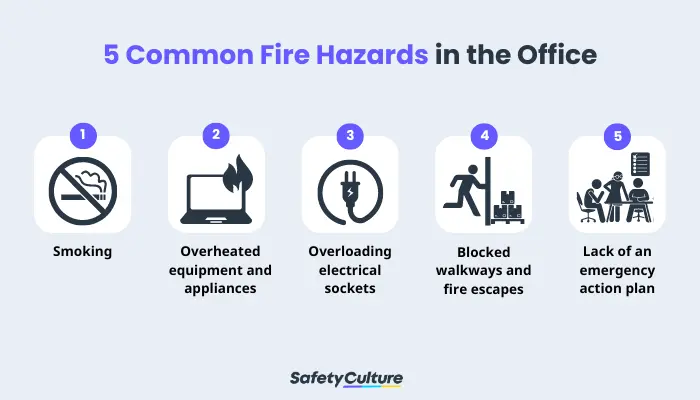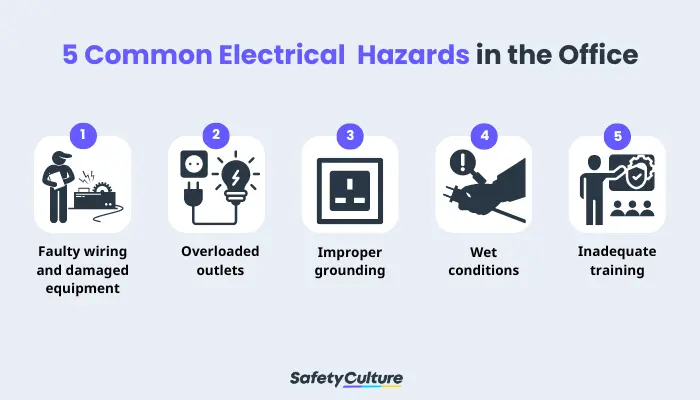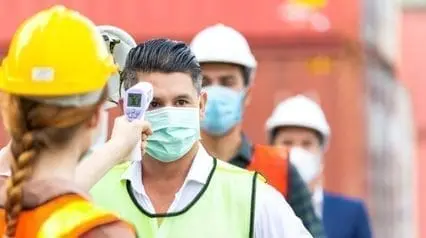What are Office Hazards?
Office hazards encompass a range of potential risks that can jeopardize the health and safety of office workers, including physical, biological, fire, and electrical hazards, among others. To address them, organizations must conduct regular risk assessments, implement ergonomic guidelines for workstation setups, provide training on safe equipment usage, promote regular breaks and physical activity, and foster a supportive work culture.
By addressing these office hazards proactively through effective hazard identification and mitigation strategies, employers can create a safer and more conducive work environment, reducing the risk of accidents, injuries, and long-term health problems among their employees.
How to Identify Office Hazards
Office risk assessments are an effective way to manage safety and health risks within an office environment. This process begins with hazard identification—identifying objects, situations, or activities that can potentially cause harm to employees.
Workers can also employ other methods, such as comprehensive safety walkarounds, inspection of historical data, and job safety analysis, along with knowing the types of hazards that can be found in the workplace.
To properly perform risk assessment in the office, employees must understand the fundamentals of workplace hazard identification. Lack of training in proper workplace hazard identification can mean the difference between a safe and healthy employee and an injured one.
Here are steps outlining how to effectively identify office safety hazards:
- Conduct a thorough walkthrough of the office space, observing for physical hazards such as loose cables, obstructed pathways, or slippery floors.
- Review incident reports and near-misses to identify recurring issues or trends indicating underlying hazards.
- Actively involve employees in the hazard identification process, as they often possess valuable insights and firsthand experience of workplace risks.
- Assess ergonomic factors by evaluating workstations, seating arrangements, and equipment usage to identify potential strains or discomfort.
- Inspect office equipment and machinery for malfunctions, improper maintenance, or lack of safety features that could pose hazards to employees.
- Conduct a comprehensive office hazards risk assessment using standardized tools or checklists to systematically identify, evaluate, and prioritize potential risks.
Create Your Own Office Safety Checklist
Eliminate manual tasks and streamline your operations.
Get started for FREEWhat are the Common Hazards in the Office?
From ergonomic issues to environmental factors, here are common office hazards examples that employers must pay attention to and employees must take precautions from:
Physical Office Hazards
Here are the risks associated with each physical hazard and how to manage them:
- Temperature – Employers and managers must address this office health hazard and ensure that employees work as comfortably to avoid low productivity (see specific laws in the UK, Australia, and the US). They can also set up monitoring solutions and devices to maintain optimal temperatures and conditions when working, especially indoors.
- Indoor Air Quality (IAQ) – In the US, 90% of people spend most of their time indoors, often in an office environment. The US Environmental Protection Agency (EPA) also reported that indoor environments sometimes have higher levels of pollutants than the outside. This makes it more important for employers to conduct indoor air quality assessments and integrate sensors to evaluate adherence to accepted air pollution thresholds.
- Noise – The US Centers for Disease Control and Prevention (CDC) estimates that over 20 million workers are exposed to potentially damaging noise at work each year. Noise, at high or low levels, can affect office safety and health by increasing stress levels, interfering with concentration, and causing hearing loss (see laws for the UK, Australia, and the US). To mitigate this, organizations must apply engineering controls at the design stage and try to choose features that will reduce noise to the minimum acceptable level.
- Slips, Trips, and Falls – Slips occur when a person’s foot loses traction with the ground surface; trips occur when a person unexpectedly catches their foot on an object or surface; and falls may result from a slip or trip but mainly occur during falls from low heights or into a hole, ditch, or body of water. To help prevent these from happening, implement good housekeeping practices, such as cleaning up spills immediately.
Explore SafetyCulture Monitoring Solution
Utilize advanced sensor technology to monitor assets, automate vital alerts, implement actions, and report urgent issues.
Talk to an expertBiological Office Hazards
Biological hazards, or biohazards, are organic substances that can pose a threat to an employee’s health. Biological hazards can include exposure to:
- mold/fungi
- spores
- pathogenic microorganisms
- human waste
- blood or other bodily fluids/tissue
- drugs/cytotoxic substances
Some may think that biohazards are limited to workplaces such as laboratories or factories, but they can also be found in seemingly comfortable offices. This is why organizations must implement proper disposal of items with biological risks, schedule regular pest control services, and provide appropriate respiratory protective equipment, especially when there’s a known outbreak.
Fire Hazards

Common Fire Hazards in the Office
An office fire incident can be devastating not only for the workers but for the public as well. It can lead to injuries and even fatalities—not to mention costly property damage. In 2022, the US National Fire Protection Agency (NFPA) reported that around 140,000 non-residential structure fires resulted in an estimated $4.0 billion in direct property damage.
Some common fire hazards include the following:
- Smoking – Discarded cigarette butts that haven’t been put out completely or have been discarded near flammable materials can cause a fire, especially in the right conditions (dry weather and some wind).
- Overheated computer equipment and kitchen appliances – Many offices have cooking facilities nowadays, whether it be an oven, stove, or microwave. Leaving it on, unattended, and/or using it unsafely can lead to a fire.
- Overloading electrical sockets – Plugging too many appliances or equipment in one power socket and improper use of extension cords can cause sockets to overheat and burst into flames.
- Blocked walkways and fire escapes – It’s essential that all office corridors and walkways are kept clear and access to fire escapes isn’t restricted because blockages could delay the evacuation of a building. Furniture and other objects must not be placed close to or in front of fire doors, as these must be accessible at all times.
- Lack of an emergency action plan – Fire emergency action plans specify how to evacuate, where to gather after, and who should perform certain critical functions. In case of an emergency in the office building, a clear emergency action plan can help avoid causing panic and fatal consequences.
Conducting in-depth fire risk assessments can help employers create targeted and sustainable action plans. Using a checklist and a dedicated platform can also complement such efforts: Fire Risk Assessment Checklists
Electrical Hazards

Common Electrical Hazards in the Office
Almost all office work today involves using equipment running on electricity. Equipment, such as photocopiers, laptops, kettle leads, and power switches, can get wet or become faulty, which can cause burns and electric shocks.
Office workers who aren’t adequately trained in electrical safety are exposed to a higher risk of such injuries, or worse, death caused by the following:
- Faulty wiring and damaged equipment – Exposure to defective electrical tools (e.g., those with wrong sizes and inadequate insulation) can be dangerous to office workers because it can cause fire incidents and electric shock.
- Overloaded outlets – Overloading power outlets expose wires to extreme temperatures, which can cause them to melt and trigger a fire in the area.
- Improper grounding – Ungrounded installations can be hazardous to the office and its inhabitants as they can cause electric shock to employees and short out computers and other appliances. Hence, electrical equipment should be earthed (an “earth” or wire should be put between a piece of electrical equipment and the ground) to achieve a low-resistance path for dissipation of current into the ground.
- Wet conditions – Oftentimes, employees get electrocuted when they touch electrical outlets or plug-in electric appliances with wet hands.
Here are some useful tips to follow in addressing electrical hazards:
- Ensure all electrical equipment is certified by a nationally recognized laboratory and read all manufacturers’ instructions carefully.
- Encourage the use of electrical inspection checklists and include all the necessary items for an effective electrical safety walkthrough.




